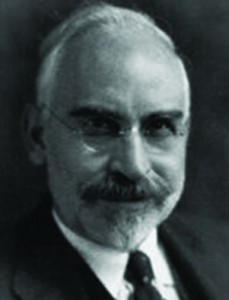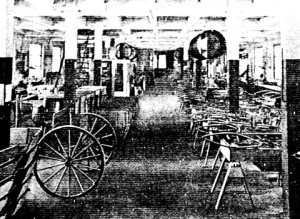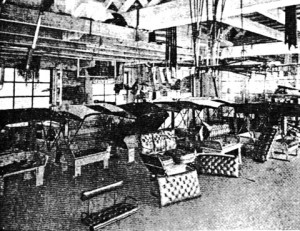Henry k. Holsman
Henry Kerchner Holsman was born in Dale, Iowa on July 3, 1866. Following his education at the local schools, he entered and studied architecture at Grinnell College in Grinnell, Iowa, graduated and practiced his profession for 65 years. Over his lifetime, he designed more than 1,000 private homes, 10 churches, 6 banks and a number of college buildings.
Among these, were the Library at Parsons College in Fairfield, Iowa; the Science Building at Ripon College in Ripon, Wisconsin; the Sociology Building at the University of Danville in Danville, Illinois; and the Chapel of the Holy Grail at the Disciples Divinity House at the University of Chicago in Chicago, Illinois. In Hyde Park, Chicago, Mr. Holsman designed apartment buildings, particularly designated for junior faculty at the University of Chicago. Some of these apartments were located at 5712 South Kenwood; 5617-19 South Dorchester; 1149-59 East 56th Street; 1321 East 56th Street; 7855-61 South Shore Drive.
Henry K. Holsman was known by many as the “father of the high wheeler” – for it was he who introduced, in 1902, the car that inspired the flood of high wheeler cars beginning some five years later. They reached their peak from 1904 – 1909; with his Holsman Automobile Company of Chicago being the industry leader.
The Holsman Automobile Company
Henry and Lucette Kerchner Holsman settled in Dale, (Dale City), Iowa sometime prior to 1865, where they purchased lot #1, of the first 25 lots made available. There they built their house and a small shop. He was a tailor, and chose this lot as it was directly across from the Woolen Mill where he could conveniently purchase the wool cloth he used in making woolen suits.
On the 3rd of July 1866, their son, Henry Kerchner Holsman was born.
Following H. K. Holsman’s education at the local schools, he entered and studied architecture at Grinnell College, Grinnell, Iowa, graduated and practiced his profession with variable intensity for 65 years.
Among the major buildings he designed were the Science Building at Ripon College, Ripon, Wisconsin; the Bacterial Laboratory and the Devine Disciples Hall at the University of Chicago, Illinois; the Sociology Building at the University of Danville, Danville, Kentucky, and the buildings for Parsons College, Fairfield, Iowa. All of which are included in 20 college buildings; 10 churches; 6 banks; and over 1,000 private homes which he designed. His wife, Elizabeth Tuttle Holsman was one of the first graduates of the Art Institute of Chicago. She was a fine artist and sculptress, providing many of the paintings and sculptures which her husband incorporated in the design of various buildings. Some of her private paintings still exist in the hands of her son and daughter-in-law, Henry T. and Marta Holsman.
H.K. Holsman then became quite interested in the newly invented automobile, and around 1900, purchased one from back East, but it did not perform to his satisfaction. The family home was at 9024 South Hoyne Ave., near Western Ave., Chicago, both of these roads, plus many others, being dirt. A major problem with this car, was that the Holsman family had to traverse these dirt roads, which became quite muddy during, and following a rain storm. The car tended to mire in the mud causing the engine to stall. Wishing to be able to drive through the mud without stalling, he purchased another make car out of St. Louis. He found that this car had the same problem, and it gave no better results than the first one. He then concluded that he could design and build a much more dependable vehicle which he would be able to drive through muddy roads without becoming stuck and stalling. This was the beginning of the Holsman Automobile Company!
Quoted from an undated legal proposition rescued from among H.K. Holsman’s papers:
“The proposition is to form a corporation with $250,000 capital; 100M preferred and 150M common. 50M of the preferred is to remain in the treasury so if the business requires money in future not now anticipated, it will not be necessary to issue bonds or borrow.”
“This leaves 200M of stock to be disposed of: 50M preferred and 150M common. The preferred is to bear 7%, and is to be given the person who furnishes the money to buy the assets, the estimate cost of which is to be $50,000. If it costs less, the amount is to be scale down in proportion. With the 50M preferred, a bonus of 25M common is to go, subject to the provision noted below. 50M more in cash will be provided for which the subscribers are to be given 100M common. This leaves 25M to go to (H. K.) Holsman, plus 1½ shares for every dollar which can be saved off the purchase price of 50M. – etc., etc.”
— They offer a five year contract at $5,000 to (H. K.) Holsman as a consulting engineer. They insist that he give his exclusive service to the corporation, but say that if he desires to carry on architectural work, they will have no objection, provided his architectural work does not take him out on superintending buildings.
“— The bank intends to take the 50M preferred, the $50,000 cash is to be furnished by a syndicate of which Leonard will be the head. — Associated with Leonard there will be probably Mr. Riley, Mr. Emory and Mr. Peronto, but Mr. Leonard will control the situation.”
There was an objection to the size of H. K. Holsman’s interest, but its outcome is not known.
In late 1901, the HOLSMAN AUTOMOBILE WORKS was established with offices in the YMCA Building, Chicago, Illinois. By late 1902 it became the HOLSMAN AUTOMOBILE COMPANY at 153 La Salle Street, Chicago.
The officers of the company were: Henry K. Holsman, Architect & Engineer as President; Ward Hildreth, Secretary & Treasurer as Manager; and H. K.’s brother, J. Arthur Holsman, Machinist as Superintendent of Works. Note: When H. K. Holsman was interviewed on 1 March 1961, at the age of 94, he stated that he did not hold a designated officer position in the company, but only worked in an office as its designer, being paid a salary for this service. This contradicts the official published information, but we may assume that because of his failing memory, and possibly some feuding between the members of management, that the prior published version is correct.
The first manufacturing facility was an old store building on the South side of Chicago, at 6344 Washington Street (near 63rd Street), which they converted into a factory.
H.K. Holsman designed a vehicle and applied for a basic covering patent on 31 July 1901, which was filed at the Patent Office 2 January 1902, application No. 70,346. Against this application, patent No. 697,720 was granted on 15 April 1902. In addition to this basic patent, he also designed several carburetors, a circuit breaker, and other innovative mechanical features applicable to the cars drivability.
He began the construction on his first car in 1901, completing and testing it by early 1902. It was built strictly for experimental purposes, WAS THE ONLY CAR BUILT IN 1902, AND IT WAS NOT SOLD!
Several makes of motors were purchased and tried out, but none proved satisfactory. They then designed their own and had it built, which proved to be to their liking. It was then apparently jobbed out to the Independent Harvester Company, Plano, Illinois for the manufacture of the individual parts. From there, they were shipped to the Holsman factory for finishing, assembling, and testing.
They called their first vehicles carriages. Using forethought, Holsman designed the first experimental motor carriage with hooks attached to the front axle so that a set of traces could be attached to allow the car to be pulled by a horse in an emergency. Following assembly of the first hand built Holsman carriage, it had to be pulled down the street until the motor fired. It caught, and ran for about one half block before stalling. They made some changes, and tried again. This time it ran for about two blocks. After many attempts, it finally operated to their satisfaction.
He introduced the Holsman high wheeler to the public at the Chicago Automobile Show in January of 1903. The first cars manufactured and advertised were Design Number 3 at $625, a single seated vehicle; Design Number 4 at $700, the number 3 with an additional seat attached to the rear of the body and heavier construction; plus Design Number 5 at $525, a stripped model 3, using long distance plain axle bearings rather than the Timken roller bearings, a single chain drive between the crankshaft and the jack shaft rather than the double chain drive, painted steering lever, cloth upholstery rather than leather, no foot mat, fenders or lamps. These changes to the Number 5 were made to obtain a cost lower than the other two models, thus a lower selling price which, it was hoped, would appeal to a larger group of potential purchasers. The Design Number 3 body was curved at the front, and obviously, rather expensive to manufacture. So, on the 1st of August 1904, they introduced a revised model 3 using the piano body, which is the one most extant to this date. As mentioned in another section, there is only one complete early model 3 known, and that is in the Henry Ford Museum, Dearborn, Michigan.
However, there is a modified early model 3 located in Denmark. Only 13 cars were manufactured in 1903 with 11 being delivered against orders for 17. His first sale was to a purchaser in South Dakota.
In April 1905, they moved to their new offices in Monadnock Block, Chicago. Production continued in the original 3,000 square foot building through early 1906, but they did manage to increase the square footage available for manufacturing to 5,000 in 1905. By the end of 1905 they were planning for additional manufacturing space and by May of 1906 they had built a new three story, 240′ x 50′, factory building with approximately 33,000 square feet of floor space available. This increased their production capacity to just over six times the existing.
The number in their work force is unknown for most of their existence, but in early 1909 they had 200 employees.
Early in 1905 they had obtained so many orders for their vehicles that they began working a night shift. This shift was halted in late fall of that year, but reactivated in December to keep up with their still increasing orders. An indication of their increasing activeness, which, of course, was directly tied to sales, may be judged by their disbursements, which rose very dramatically. They used these figures as a means of increasing their rating at the local bank.
| For | 1903 1904 1905 1906 1907 1908 1909 |
$ 12,320 $ 28,313 $ 87,303 $278,808 $602,100 $363,176 $485,404 |
On January 1st 1906, Treasurer and Manager, Ward Hildreth predicted sales of over a quarter of a million dollars for that year. Actual vehicle sales figures for that year exceeded Hildreth’s prediction by just over $5,000.
DUER: In 1905, Charles Duer, Superintendent of the Chicago Coach & Carriage Company, began experimenting with the intent of producing a high wheel automobile. On 13 January 1906, a patent application was filed by Coffman & Cherry, who were evidently representing Duer. The patent was granted on 14 August 1906, No. 828,713. Then, in 1907, following two years of experimentation, Charles Duer placed into production a high wheel vehicle named the DUER. This car had a 2 cylinder, opposed, air cooled engine, tiller steering, and rope drive, all very similar to the HOLSMAN. These events came to the attention of H. K. Holsman, who contacted his attorney, John Howard McElroy, and verbally requested an opinion about the possible infringement of the claims of his patent No. 697,620. Attorney McElroy answered, via his five page letter of 24 November 1906, that Duer’s patent did, in fact, infringe on claims No’s 1, 2 & 5, but not on 3 & 4.
This was followed by Attorney McElroy’s three page formal opinion letter of 25 November 1906, which covered the same conclusions. In essence, he recommended to H. K. Holsman that he proceed to the point of the preliminary statements to ascertain whether or not he was the prior inventor. Nothing further has been found regarding this matter.
Due to the severe winters in the Midwest area, cars did not sell very well, but did so in the other three seasons. Accordingly, Holsman normally built practically all of his cars in December through March or April of each year, with production sometimes starting in November and extending into May. This schedule resulted in most of their cash being tied up inventory by spring. It was then slowly returned to cash as the cars were delivered, paid for, and more orders for cars obtained.
After the highly successful sales years of 1906 and 1907, the company appeared to have spent considerably on raw material and parts in anticipation of continuing high sales. The 1908 orders slackened, and the company found itself in a short cash flow condition.
In the fall of 1909, their manager borrowed money from a local Stockyard bank for the purchase of parts to be used in their winter construction. By spring, they had acquired a sizable inventory of cars and their money was tied up in this inventory. Repayment of this money was due in March 1910. On the 24th of February 1910, a Western Union Telegram was delivered to H. K. Holsman, c/o A. Cattell, 1017, 134 Monroe Street, Chicago, from O. J. Fee in Lincoln, Nebraska, which was quite disheartening; “Expert accountant advises letting factory go and starting new on small scale. Can’t raise money for tomorrow.” This undoubtedly was the death knell for the Holsman automobile.
April 1910, H. K. Holsman joined the Independent Harvester Company.
Holsman had never stopped his architectural career, but it continued, in a lesser way, while he was involved with the Holsman Automobile Company and the Independent Harvester Company. Thus, when he left the Independent Harvester Company, he was again able to devote full time to architecture, which he did until his retirement.
Recorded traces of H. K. Holsman’s automotive involvement vanished following his short career with the I.H.C., but he was later located, by antique car enthusiast Roy Tetslaff, in a nursing home in Genoa City, Wisconsin. Mr. Tetslaff was granted permission to interview him, and did so, on tape, on March 1st, 1961. H. K. Holsman was then 94 years of age, and a review of this tape reveals that not only did he occasionally contradict himself, but also contradicted prior known facts, making statements later found to be untrue. These contradictions are most understandable when one considers his age, and the laps of time between the actual events and the interview.
On 15 May 1963, H. K. Holsman, the man who introduced the high wheel automobile to America, and the world, passed away, at Genoa City, Wisconsin, and was buried at Lake Geneva, Wisconsin.





